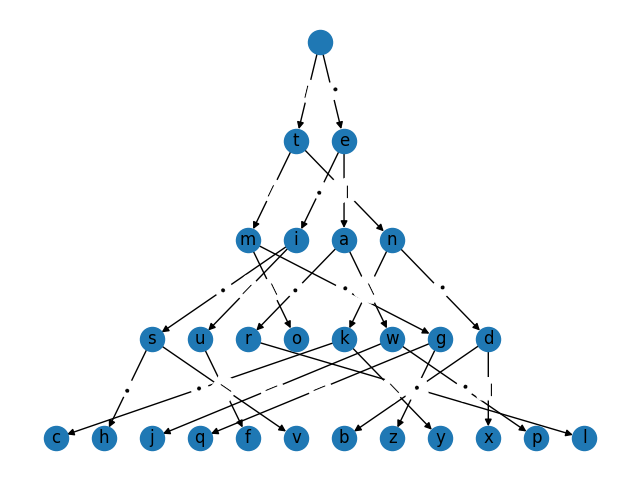Note
Go to the end to download the full example code.
Morse Trie#
A prefix tree (aka a “trie”) representing the Morse encoding of the alphabet. A letter can be encoded by tracing the path from the corresponding node in the tree to the root node, reversing the order of the symbols encountered along the path.

•• •—•• ——— •••— • —• • — •—— ——— •—• —•— —••—
import networkx as nx
# Unicode characters to represent the dots/dashes (or dits/dahs) of Morse code
dot = "•"
dash = "—"
# Start with the direct mapping of letter -> code
morse_direct_mapping = {
"a": dot + dash,
"b": dash + dot * 3,
"c": dash + dot + dash + dot,
"d": dash + dot * 2,
"e": dot,
"f": dot * 2 + dash + dot,
"g": dash * 2 + dot,
"h": dot * 4,
"i": dot * 2,
"j": dot + dash * 3,
"k": dash + dot + dash,
"l": dot + dash + dot * 2,
"m": dash * 2,
"n": dash + dot,
"o": dash * 3,
"p": dot + dash * 2 + dot,
"q": dash * 2 + dot + dash,
"r": dot + dash + dot,
"s": dot * 3,
"t": dash,
"u": dot * 2 + dash,
"v": dot * 3 + dash,
"w": dot + dash * 2,
"x": dash + dot * 2 + dash,
"y": dash + dot + dash * 2,
"z": dash * 2 + dot * 2,
}
### Manually construct the prefix tree from this mapping
# Some preprocessing: sort the original mapping by code length and character
# value
morse_mapping_sorted = dict(
sorted(morse_direct_mapping.items(), key=lambda item: (len(item[1]), item[1]))
)
# More preprocessing: create the reverse mapping to simplify lookup
reverse_mapping = {v: k for k, v in morse_direct_mapping.items()}
reverse_mapping[""] = "" # Represent the "root" node with an empty string
# Construct the prefix tree from the sorted mapping
G = nx.DiGraph()
for node, char in morse_mapping_sorted.items():
pred = char[:-1]
# Store the dot/dash relating the two letters as an edge attribute "char"
G.add_edge(reverse_mapping[pred], node, char=char[-1])
# For visualization purposes, layout the nodes in topological order
for i, layer in enumerate(nx.topological_generations(G)):
for n in layer:
G.nodes[n]["layer"] = i
pos = nx.multipartite_layout(G, subset_key="layer", align="horizontal")
# Flip the layout so the root node is on top
for k in pos:
pos[k][-1] *= -1
# Visualize the trie
nx.draw(G, pos=pos, with_labels=True)
elabels = {(u, v): l for u, v, l in G.edges(data="char")}
nx.draw_networkx_edge_labels(G, pos, edge_labels=elabels)
# A letter can be encoded by following the path from the given letter (node) to
# the root node
def morse_encode(letter):
pred = next(G.predecessors(letter)) # Each letter has only 1 predecessor
symbol = G[pred][letter]["char"]
if pred != "":
return morse_encode(pred) + symbol # Traversing the trie in reverse
return symbol
# Verify that the trie encoding is correct
import string
for letter in string.ascii_lowercase:
assert morse_encode(letter) == morse_direct_mapping[letter]
print(" ".join([morse_encode(ltr) for ltr in "ilovenetworkx"]))
Total running time of the script: (0 minutes 0.226 seconds)